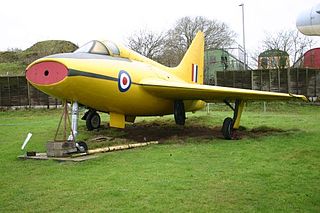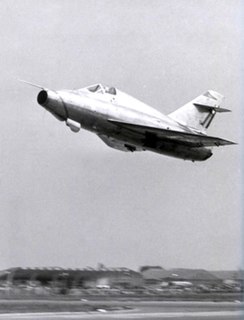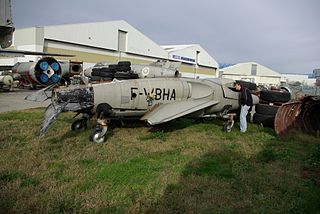
The Fouga CM.170 Magister is a 1950s French two-seat jet trainer aircraft that was developed and manufactured by French aircraft manufacturer Fouga. Due to industrial mergers, the aircraft has been variously known as the Fouga CM.170 Magister, Potez (Fouga) CM.170 Magister, Sud Aviation (Fouga) CM.170 Magister and Aérospatiale (Fouga) CM.170 Magister, depending on where and when they were built.

The Nord 1500 Griffon was an experimental ramjet-powered interceptor aircraft designed and built by French state-owned aircraft manufacturer Nord Aviation. The Griffon was developed to become a Mach 2 follow on to the supersonic Nord Gerfaut research aircraft. Development of the aircraft began in earnest after the receipt of a letter of intent in 1953 for a pair of unarmed research aircraft. The design featured an innovative dual propulsion turbojet-ramjet configuration; the former being used to takeoff and attain sufficient speed to start the latter.

The Boulton Paul P.111 is an experimental aircraft designed and produced by the British aircraft manufacturer Boulton Paul. It was amongst the first aircraft designed to explore the characteristics of the tailless delta wing configuration.

The Short SB.4 Sherpa was an experimental aircraft designed and produced by the British aircraft manufacturer Short Brothers. Only a single example was ever produced.

The Ambrosini Sagittario was an Italian aerodynamic research aircraft based on the manufacturer's S.7. New swept wings and tail surfaces of wooden construction were fitted to the S.7 fuselage. The wing leading edge was swept at 45 degrees. At first, the S.7's piston engine was retained and the aircraft was known as the Ambrosini S.7 Freccia (Arrow).

The Arsenal VG 90 was a French carrier-based jet-engined interceptor developed in the late 1940s. It was intended to compete for an Aéronavale contract and first flew in 1949. It set a speed record for a French aircraft the following year, but both of the completed prototypes were destroyed in fatal crashes and the program was cancelled in 1952 before the third prototype was finished. The Aéronavale contract was eventually awarded to a license-built British aircraft. The remains of the last VG 90 were scrapped in 1978.

The Ikarus 451 is a family of research aircraft designs built in Yugoslavia in the 1950s, all sharing the same basic airframe, but differing in powerplants and cockpit arrangements. One member of the family Ikarus 451M became the first domestically-built jet aircraft to fly in Yugoslavia, on 25 October 1952.

The Nord Gerfaut (Gyrfalcon) was a French delta-wing experimental research aircraft. It was the first European aircraft to exceed Mach 1 in level flight without the use of an afterburner. A pair of aircraft were built for the primary purpose of investigating the transonic regime. The Gerfaut I conducted its maiden flight in 1954; it was followed by the improved Gerfaut II two years later. Both aircraft were flown for several years for experimental purposes, being significantly upgraded over time. During the course of these test flights, the second prototype establishment multiple time-to-altitude world records. In the late 1950s, the type was used to flight-test various aerial missiles. Both aircraft performed their final flights in 1959; they were subsequently used as targets at the Military Test Range at Cazaux.

The Yakovlev Yak-1000 was a Soviet supersonic technology demonstrator intended to evaluate the aerodynamic layout and field performance of the cropped delta wing discussed in captured German documents in combination with the new Lyulka AL-5 turbojet. The tandem undercarriage proved to be unsatisfactory and there were serious flight stability problems related to the delta wing, enough so that it never flew after an accident during taxiing tests.

The Caproni Trento F.5 was a small Italian two-seat trainer designed by Stelio Frati and built by Aeroplani Caproni Trento. The F.5 was not ordered into production and only a prototype was built.
The Somers-Kendall SK-1 was a light jet-powered 1950s British two-seat racing monoplane, designed by Hugh Kendall and built by Somers-Kendall Aircraft Limited at Woodley Aerodrome.
The SIPA S.300 was a French turbojet powered basic trainer, claimed to be the first of its kind anywhere. Only one was built, the prototype crashing after a year's development.
The NRC tailless glider, also called the NRL tailless glider, was a two-seat tailless research glider designed by the National Research Council of Canada and built by the National Research Laboratories, at the instigation of G.T.R. Hill who had previously designed the British Westland-Hill Pterodactyl series of tailless aircraft.
The Procaer Cobra was a two-seat turbojet powered light aircraft designed and built in Italy and flown in the early 1960s. Only one was completed.

The CVV-6 Canguro was a high performance two seat glider, designed at Milan Polytechnic University in 1940. A small batch was ordered for the Italian Air Force but few were delivered; more were produced after World War II, becoming the most common Italian gliding club machine. Some were still in use in the 1980s. In 1954 a Canguro came second at the World Gliding Championships at Camphill Great Hucklow, Derbyshire, England. One was modified into a powered aircraft, at first with a piston engine and later with a turbojet.

The Payen Arbalète was a small, pusher configuration, experimental French tailless aircraft, designed by Nicolas Roland Payen, and first flown in 1965.
The Payen Pa.47 Plein Air was a French two seat, high wing single engine tourer, which first flew in 1949. Only one was built.

The SNCASO Deltaviex or SNCASO-ONERA Deltaviex was a small French experimental jet aircraft, first flown 30 April 1954 and distinguished by highly swept, small span wings. It was designed to explore the possibility of controlling roll and yaw with fine jets of air bled from the engine's compressor.
Nicolas Roland Payen was a French aeronautical engineer. He has been described as the originator of the delta wing.
The RRG Delta I was a German experimental tailless aircraft flown in the early 1930s first as a glider and then powered. It was one of the first delta wing aircraft.
















